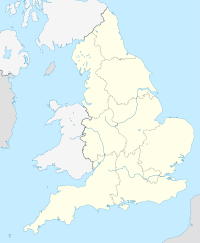Ewelme
Coordinates: 51 ° 37 ′ N , 1 ° 4 ′ W
Ewelme is a village and " civil parish " (parish) in the south of the British county of Oxfordshire with 1,103 inhabitants (2001).
location
The place is 80 to 100 meters above sea level in a narrow valley of the Chiltern foothills, a range of hills northwest of London , four kilometers northeast of Wallingford , south of the B 4009, north of the A 4130 and east of the A 4074.
Parish Church of St Mary the Virgin
The “Church of St. Virgin Mary “was under King Edward III. Erected around 1436 by bricklayers and craftsmen who were in the service of William de la Pole , Duke of Suffolk , and his wife Alice, granddaughter of the poet Geoffrey Chaucer . It is a typical example of the light-flooded sacral space of the Perpendicular Style . Since the style is very uniform, the construction time will only have been a few years. The outer walls in the east of the church are patterned through the use of light and dark stones. The bell tower in the west comes from the previous building of the Early English Style . The roof of the church is not stepped from east to west, a choir arch is missing; only a rood screen marks the dividing line to the choir. The main entrance is in the north of the church.
Furnishing
- The canopy of the baptismal font, carved from oak, is one of the most beautiful in England - a gift from John de la Pole , Duke of Suffolk, in 1513. In 1823 it was partially restored.
- In the main nave, on the two rearmost pillars next to the tower, there are two small stone heads that probably symbolize church and state. The head on the pillar next to the baptismal font is said to represent King Edward III, patron of Geoffrey Chaucer. The arches on the north side of the main nave are more richly decorated than those on the south side.
- The rood screen (15th century) consists of iron rods on oak panels and is rare in this form; Originally there was a rood screen gallery, as wall openings show on both sides.
- The wooden pulpit to the right of the rood screen shows carved coats of arms of the noble families Roet and Burghersh, in which the Chaucers married.
- On the north side of the choir, a baroque plaque commemorates Francis Martyn († 1682), who came from Ewelme as a parliamentarian and was able to save the church from plundering during the civil war.
- The main nave's colored east window is a modern work by Clayton and Bell. The crucifixion scene is shown.
- The St. John Chapel (John the Baptist) on the south side of the choir is a fine example of the Perpendicular Style. It has a carved ceiling. The east window of this chapel contains glass fragments from the 15th century. The walls are painted with the Christ monogram " IHS " in Gothic letters . The floor tiles in the chapel's chancel are remnants of the original floor from the 15th century.
- The tomb of Thomas Chaucer († 1434) and his wife Matilda Burghersh was built in 1438. It is made of gray Purbeck marble . The inscriptions and the many coats of arms reproduced here were restored in 1848.
- The late Gothic tomb of Alice de la Pole († 1475) was built by her son, the 2nd Duke of Suffolk. The tomb and the figures are made of alabaster ; the deceased is shown lying twice, once on the top and once on the floor below the sarcophagus , there as a partially decayed figure. The tomb has obviously been shortened before it was placed on the right between the choir and St. John's Chapel. At the bottom of the sarcophagus there are frescoes that can only be seen when the viewer lies on the floor; they show St. John the Baptist , the Annunciation Scene and St. Mary Magdalene . On small stone pillars at the upper edge of the tomb there are four angels or archangels made of wood.
Jerome tombs
In the southern part of the church cemetery, to the right of the path to the so-called Old Rectorate, there are three tombstones of the Jerome family. The one on the left is that of the writer Jerome K. Jerome , the author of "Three Men in One Boat".
Poor houses and school
Immediately to the west of the church and connected to it by a covered corridor are almshouses in a square , formerly also called St John's Hospital, founded in 1437 by Alice de la Pole for 12 or 13 old and poor male residents and built of red brick . The inhabitants lived like a monastery according to strict rules, written between 1448 and 1450, which were, however, softened over time. They were obliged to pray regularly for the donor family in the church. A school building, one of the oldest in England, has survived from the same era and is still used as such. Together with the poor houses, which are now designed for eight residents, the school is managed by a foundation.
literature
- Simon Jenkins: England's Thousand Best Churches . London: Penguin Books 1999/2009, pp. 627f.







